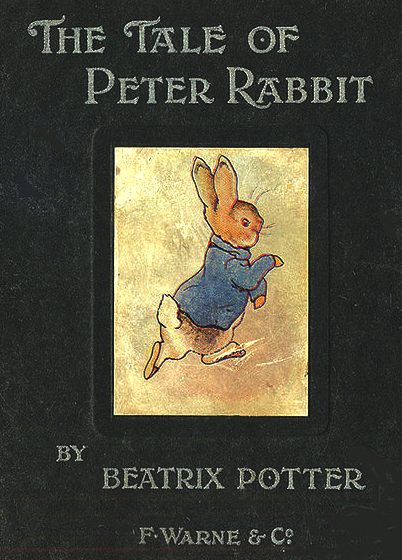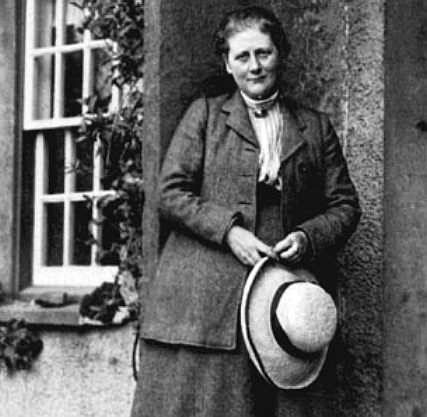|
Helen Beatrix Potter (28 July 1866 – 22 December 1943) was an
English author, illustrator, natural scientist and conservationist best known for her imaginative children’s books featuring animals such as those in The Tale of Peter Rabbit which celebrated the British landscape and country life.

Born into a privileged Unitarian family, Potter, along with her younger brother, Walter Bertram (1872–1918), grew up with few friends outside her large extended family. Her parents were artistic, interested in nature and enjoyed the countryside. As children, Beatrix and Bertram had numerous small animals as pets which they observed closely and drew endlessly. Summer holidays were spent in
Scotland and in the English Lake District where Beatrix developed a love of the natural world which was the subject of her painting from an early age.
She was educated by private governesses until she was eighteen. Her study of languages, literature, science and history was broad and she was an eager student. Her artistic talents were recognized early. Although she was provided with private
art lessons, Potter preferred to develop her own style, particularly favouring
watercolour. Along with her drawings of her animals, real and imagined, she illustrated insects, fossils, archeological artefacts, and fungi. In the 1890s her mycological illustrations and research on the reproduction of fungi spores generated interest from the scientific establishment. Following some success illustrating cards and booklets, Potter wrote and illustrated The Tale of Peter Rabbit publishing it first privately in 1901, and a year later as a small, three-colour illustrated book with Frederick Warne & Co. She became unofficially engaged to her editor Norman Warne in 1905 despite the disapproval of her parents, but he died suddenly a month later, of
leukemia.
With the proceeds from the books and a legacy from an aunt, Potter bought Hill Top Farm in Near Sawrey, a tiny village in the
English Lake District near Ambleside in 1905. Over the next several decades, she purchased additional farms to preserve the unique hill country landscape. In 1913, at the age of 47, she married William Heelis, a respected local solicitor from Hawkshead. Potter was also a prize-winning breeder of Herdwick
sheep and a prosperous farmer keenly interested in land preservation. She continued to write, illustrate and design spin-off merchandise based on her children’s books for Warne until the duties of land management and diminishing eyesight made it difficult to continue. Potter published over twenty-three books; the best known are those written between 1902 and 1922. She died on 22 December 1943 at her home in Near Sawrey at age 77, leaving almost all her property to the National Trust. She is credited with preserving much of the land that now comprises the
Lake District National Park.
Potter’s books continue to sell throughout the world, in multiple languages. Her stories have been retold in song, film,
ballet and animation.

LITERARY
CAREER
Potter’s artistic and literary interests were deeply influenced by fairies, fairy tales and fantasy. She was a student of the classic fairy tales of Western
Europe. As well as stories from the Old Testament, John Bunyan's The Pilgrim's Progress and Harriet Beecher Stowe's Uncle Tom's Cabin, she grew up with Aesop’s Fables, the fairy tales of the Brothers Grimm and Hans Christian Andersen, Charles Kingsley's The Water
Babies, the folk tales and mythology of Scotland, the German Romantics,
Shakespeare, and the romances of Sir Walter Scott. As a young child, before the age of eight, Edward Lear's Book of Nonsense, including the much loved The Owl and the Pussycat, and Lewis Carroll's Alice in Wonderland had made their impression, although she later said of Alice that she was more interested in Tenniel's illustrations than what they were
about. The Brer Rabbit stories of Joel Chandler Harris had been family favourites and she later studied his Uncle Remus stories and illustrated
them. She studied book illustration from a young age and developed her own tastes, but the work of the picture book triumvirate Walter Crane, Kate Greenaway and Randolph Caldecott, the last an illustrator whose work was later collected by her father, was a great
influence. When she started to illustrate, she chose first the traditional rhymes and stories, "Cinderella", "Sleeping Beauty", "Ali Baba and the Forty Thieves", "Puss-in-boots", and "Red Riding
Hood". But most often her illustrations were fantasies featuring her own pets: mice, rabbits, kittens, and guinea
pigs.
In her teenage years Potter was a regular visitor to the art galleries of London, particularly enjoying the summer and winter exhibitions at the Royal Academy in
London. Her Journal reveals her growing sophistication as a critic as well as the influence of her father’s friend the artist Sir John Everett Millais who recognised Beatrix’s talent of observation. Although Potter was aware of art and artistic trends, her drawing and her prose style were uniquely her
own.
As a way to earn a bit of money in the 1890s, Beatrix and her brother began to print
Christmas cards of their own design, as well as cards for special occasions. Mice and rabbits were the most frequent subject of her fantasy paintings. In 1890 the firm of Hildesheimer and Faulkner bought several of her drawings of her rabbit, Benjamin Bunny, to illustrate verses by Frederic Weatherly titled A Happy Pair. In 1893 the same printer brought several more drawings for Weatherly’s Our Dear Relations, another book of rhymes, and the following year Potter successfully sold a series of frog illustrations and verses for Changing Pictures, a popular annual offered by the art publisher Ernest Nister. Potter was pleased by this success and determined to publish her own illustrated
stories.

Whenever Potter went on holiday to the Lake District or Scotland, she sent letters to young friends illustrating them with quick sketches. Many of these letters were written to the children of her former governess Annie Carter Moore, particularly to her eldest son Noel who was often ill. In September 1893 Potter was on holiday at Eastwood in Dunkeld, Perthshire. She had run out of things to say to Noel and so she told him a story about "four little rabbits whose names were Flopsy, Mopsy, Cottontail and Peter." It became one of the most famous children’s letters ever written and the basis of Potter’s future career as a
writer-artist-storyteller.
In 1900, Potter revised her tale about the four little rabbits, and fashioned a dummy book of it - it has been suggested, in imitation of Helen Bannerman's 1899 bestseller The Story of Little Black
Sambo. Unable to find a buyer for the work, she published it for family and friends at her own expense in December 1901. It was drawn in black and white with a coloured frontispiece. Family friend Canon Hardwicke Rawnsley had great faith in Potter's tale, recast it in didactic verse, and made the rounds of the London publishing houses. Frederick Warne & Co. had previously rejected the tale but, eager to compete in the booming small format children's book market, reconsidered and accepted the "bunny book" (as the firm called it) following the recommendation of their prominent children's book artist L. Leslie
Brooke. The firm declined Rawnsley's verse in favour of Potter's original prose, and Potter agreed to colour her pen and ink illustrations, choosing the then-new Hentschel three-colour process for reproducing her
watercolours.
On 2 October 1902 The Tale of Peter Rabbit was
published, and was an immediate success. It was followed the next year by The Tale of Squirrel Nutkin and The Tailor of Gloucester which had also first been written as picture letters to the Moore children. Working with Norman Warne as her editor, Potter published two or three little books each year for a total of twenty-three books. The last book in this format was Cecily Parsley's Nursery Rhymes in 1922, a collection of favourite rhymes. Although The Tale of Little Pig Robinson was not published until 1930, it had been written much earlier. Potter continued creating her little books until after the
First World War when her energies were increasingly directed toward her farming, sheep-breeding and land
conservation.
The immense popularity of Potter’s books was based on the lively quality of her illustrations, the non-didactic nature of her stories, the depiction of the rural countryside, and the imaginative qualities she lent to her animal characters.
Potter was also a canny businesswoman. As early as 1903 she made and patented a Peter Rabbit doll. It was followed by other "spin-off" merchandise over the years, including painting books, board games, wall-paper, figurines, baby blankets and china tea-sets. All were licensed by Frederick Warne & Co. and earned Potter an independent income as well as immense profits for her
publisher.
In 1905, Potter and Norman Warne became unofficially engaged. Potter's parents objected to the match because Warne was "in trade" and thus not socially suitable. Sadly the engagement lasted only one month when Warne died of leukemia at age
thirty-seven. That same year Potter used some of her income and a small inheritance from an aunt to buy Hill Top Farm in Near Sawrey in Lancashire in the English Lake District. Potter and Warne may have hoped that Hill Top Farm would be their holiday home, but after Warne's death Potter went ahead with its purchase as she had always wanted to own that farm and live in "that charming village".
PUBLICATIONS
-
The Tale of Peter
Rabbit (1902)
-
The Tale of Squirrel Nutkin (1903)
-
The Tailor of Gloucester (1903)
-
The Tale of Benjamin Bunny (1904)
-
The Tale of Two Bad Mice (1904)
-
The Tale of Mrs. Tiggy-Winkle (1905)
-
The Tale of the Pie and the Patty-Pan (1905)
-
The Tale of Mr. Jeremy Fisher (1906)
-
The Story of A Fierce Bad Rabbit (1906)
-
The Story of Miss Moppet (1906)
-
The Tale of Tom
Kitten (1907)
-
The Tale of Jemima
Puddle-Duck (1908)
-
The Tale of Samuel Whiskers or, The Roly-Poly Pudding (1908)
-
The Tale of the Flopsy Bunnies (1909)
-
The Tale of Ginger and Pickles (1909)
-
The Tale of Mrs. Tittlemouse (1910)
-
The Tale of Timmy Tiptoes (1911)
-
The Tale of Mr. Tod (1912)
-
The Tale of Pigling Bland (1913)
-
Appley Dapply's Nursery Rhymes (1917)
-
The Tale of Johnny Town-Mouse (1918)
-
Cecily Parsley's Nursery Rhymes (1922)
-
The Tale of Little
Pig Robinson (1930)
NOVELIST
INDEX
A - Z
GRAPHIC
NOVEL INDEX
A - Z
|
Peter
the Rabbit
- Youtube
|
Pigling
- Youtube
|
|
Tom
& Jemima
- Youtube
|
Mr
Tod - Youtube
|
LINKS:
Beatrix
Potter’s fossils and her interest in geology - B. G. Gardiner
Works
by Beatrix Potter at Project
Gutenberg (plain text and HTML)
Collection
of Potter materials at Victoria
and Albert Museum
Beatrix
Potter online feature at the University of Pittsburgh School of
Information Sciences
Beatrix
Potter in Cumbria
Beatrix
Potter Society, UK
Beatrix
Potter's World
Frederick
Warne and Company
Beatrix
Potter, A Life in Nature
A
taste for adventure

A
heartwarming adventure: pirate
whalers V conservationists.
|

